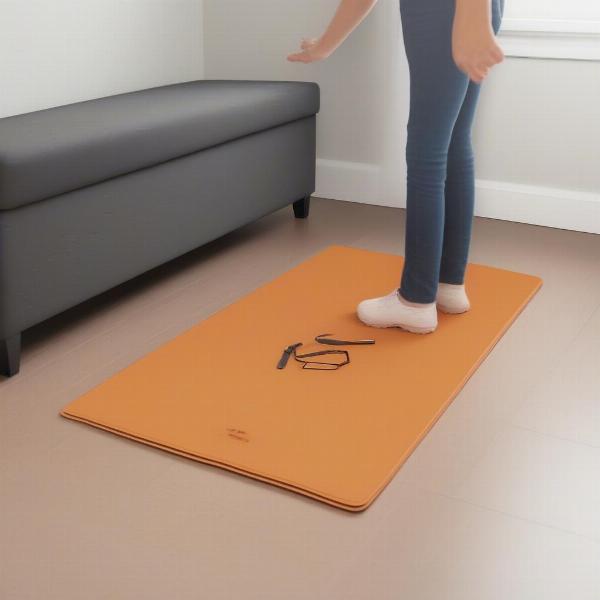Shock mats, also known as scat mats, are designed to deter pets from entering restricted areas or engaging in unwanted behaviors like scratching furniture or counter surfing. They deliver a mild, harmless static pulse when touched, surprising the dog and discouraging them from repeating the action. But are shock mats right for your dog? This guide explores the uses, benefits, and potential drawbacks of shock mats, helping you decide if they’re a suitable training tool for your furry friend.
Understanding How Shock Mats Work
Shock mats operate on batteries and deliver a low-voltage static pulse when pressure is applied. This static pulse is similar to the shock you might receive when touching a doorknob after walking across a carpeted floor. It’s unpleasant but not harmful. The surprise of the static correction is usually enough to deter a dog from touching the mat again. The intensity of the pulse can often be adjusted to suit the dog’s size and temperament. It’s important to emphasize that these mats are designed to startle, not to hurt.
Are Shock Mats Safe for Dogs?
While generally safe, shock mats can cause anxiety and fear in some dogs, especially sensitive or anxious individuals. The sudden, unexpected correction can be stressful, potentially leading to negative associations with the area or even increased fearfulness. It’s crucial to carefully introduce the mat and monitor your dog’s reaction. Never use a shock mat on a puppy younger than six months old. barking dog collars for small dogs might be a more suitable option for addressing barking issues in smaller breeds.
Using Shock Mats Effectively
 Shock Mat Placement for Training
Shock Mat Placement for Training
Shock mats should never be used as a primary training method. They are best employed as a deterrent in conjunction with positive reinforcement training. For example, if you’re trying to keep your dog off the furniture, place the mat on the sofa and simultaneously train your dog to use their bed with rewards and praise. This way, they learn an alternative behavior and associate the mat with an unpleasant experience. You can also consider rattlesnake training for dogs as a proactive measure to protect your dog from potential dangers.
Choosing the Right Shock Mat
Shock mats come in various sizes and configurations. Choose a mat that’s appropriately sized for the area you’re trying to protect and the size of your dog. Some mats offer adjustable intensity settings, allowing you to customize the correction to your dog’s sensitivity. Always follow the manufacturer’s instructions carefully. If you have two dogs and are looking for leash options, check out our article on dog leash for two dogs.
Alternatives to Shock Mats
There are several humane and effective alternatives to shock mats, including:
- Positive reinforcement training: Rewarding desired behaviors is the most effective and humane way to train a dog.
- Environmental management: Blocking access to restricted areas or removing tempting objects can prevent unwanted behaviors.
- Repellents: Certain scents, like citrus, can deter dogs from specific areas.
- Indoor pet barriers: These create invisible boundaries that keep pets contained within a designated space.
If you’re struggling with excessive barking, especially in small breeds, explore our article on the best no bark collar for small dogs for alternative solutions. For those interested in bark collars with shock functionality, our article on dog collar barking shock provides further information.
Conclusion
Shock mats can be a useful tool for deterring unwanted behaviors in dogs, but they should be used responsibly and in conjunction with positive reinforcement training. Always prioritize your dog’s well-being and consider the potential for anxiety or fear before using a shock mat.
FAQ
- Are shock mats cruel? When used correctly and responsibly, shock mats are not cruel. They deliver a mild static correction, similar to the static shock you might get from a doorknob.
- Can I use a shock mat on a puppy? It is not recommended to use a shock mat on a puppy younger than six months old.
- How do I introduce a shock mat to my dog? Start by letting your dog investigate the mat without activating it. Then, turn it on the lowest setting and encourage your dog to approach it. Reward them if they avoid it.
- What if my dog becomes afraid of the shock mat? If your dog shows signs of fear or anxiety, discontinue use immediately and consider alternative training methods.
- Can I leave the shock mat on all the time? It’s best to use the shock mat only when necessary and supervise your dog while it’s in use.
- Are there different types of shock mats? Yes, shock mats come in various sizes and with different intensity settings.
- Can I use a shock mat to train my dog to stay in their bed? While you can place the mat around the bed to deter them from leaving, it’s more effective to train them positively to stay in their bed using rewards and praise.
About ILM Dog: ILM Dog is your go-to resource for expert advice on all aspects of dog care, from breed selection and health to training and nutrition. We’re dedicated to providing dog owners worldwide with reliable, practical information to help them raise happy, healthy companions. For personalized guidance or to learn more about our services, contact us at [email protected] or call us at +44 20-3965-8624.